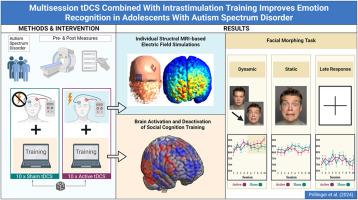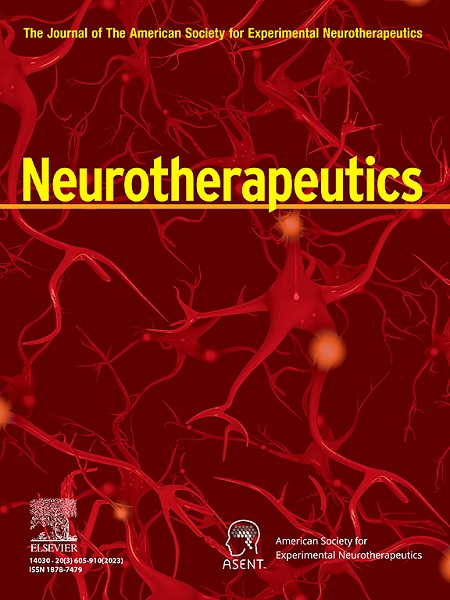Multisession tDCS combined with intrastimulation training improves emotion recognition in adolescents with autism spectrum disorder
IF 5.6
2区 医学
Q1 CLINICAL NEUROLOGY
引用次数: 0
Abstract
Previous studies indicate that transcranial direct current stimulation (tDCS) is a promising emerging treatment option for autism spectrum disorder (ASD) and its efficacy could be augmented using concurrent training. However, no intrastimulation social cognition training for ASD has been developed so far. The objective of this two-armed, double-blind, randomized, sham-controlled clinical trial is to investigate the effects of tDCS combined with a newly developed intrastimulation social cognition training on adolescents with ASD. Twenty-two male adolescents with ASD were randomly assigned to receive 10 sessions of either anodal or sham tDCS at F3/right supraorbital region together with online intrastimulation training comprising basic and complex emotion recognition tasks. Using baseline magnetic resonance imaging data, individual electric field distributions were simulated, and brain activation patterns of the training tasks were analyzed. Additionally, questionnaires were administered at baseline and following the intervention. Compared to sham tDCS, anodal tDCS significantly improved dynamic emotion recognition over the course of the sessions. This task also showed the highest activations in face processing regions. Moreover, the improvement was associated with electric field density at the medial prefrontal cortex and social awareness in exploratory analyses. Both groups showed high tolerability and acceptability of tDCS, and significant improvement in overall ASD symptoms. Taken together, multisession tDCS improved dynamic emotion recognition in adolescents with ASD using a task that activates brain regions associated with the social brain network. The variability in the electric field might diminish tDCS effects and future studies should investigate individualized approaches.

多疗程 tDCS 与体内刺激训练相结合可提高自闭症谱系障碍青少年的情绪识别能力。
以往的研究表明,经颅直流电刺激(tDCS)是治疗自闭症谱系障碍(ASD)的一种很有前景的新兴治疗方法,其疗效可通过同步训练得到增强。然而,迄今为止尚未开发出针对自闭症谱系障碍的电刺激社会认知训练。这项双臂、双盲、随机、假对照临床试验旨在研究 tDCS 与新开发的刺激内社会认知训练相结合对 ASD 青少年的影响。22名患有自闭症的男性青少年被随机分配到F3/右眶上区接受10次阳极或假tDCS治疗,同时接受包括基本和复杂情绪识别任务的在线刺激训练。利用基线磁共振成像数据模拟了个体电场分布,并分析了训练任务的大脑激活模式。此外,还在基线和干预后进行了问卷调查。与假tDCS相比,阳极tDCS在疗程中显著提高了动态情绪识别能力。这项任务也显示出人脸处理区域的激活度最高。此外,在探索性分析中,这种改善与内侧前额叶皮层的电场密度和社会意识有关。两组患者对 tDCS 的耐受性和可接受性都很高,整体 ASD 症状也有显著改善。综上所述,通过一项能激活与社交脑网络相关的脑区的任务,多节tDCS改善了患有自闭症的青少年的动态情绪识别能力。电场的可变性可能会减弱tDCS的效果,未来的研究应该探究个性化的方法。
本文章由计算机程序翻译,如有差异,请以英文原文为准。
求助全文
约1分钟内获得全文
求助全文
来源期刊

Neurotherapeutics
医学-神经科学
CiteScore
11.00
自引率
3.50%
发文量
154
审稿时长
6-12 weeks
期刊介绍:
Neurotherapeutics® is the journal of the American Society for Experimental Neurotherapeutics (ASENT). Each issue provides critical reviews of an important topic relating to the treatment of neurological disorders written by international authorities.
The Journal also publishes original research articles in translational neuroscience including descriptions of cutting edge therapies that cross disciplinary lines and represent important contributions to neurotherapeutics for medical practitioners and other researchers in the field.
Neurotherapeutics ® delivers a multidisciplinary perspective on the frontiers of translational neuroscience, provides perspectives on current research and practice, and covers social and ethical as well as scientific issues.
 求助内容:
求助内容: 应助结果提醒方式:
应助结果提醒方式:


